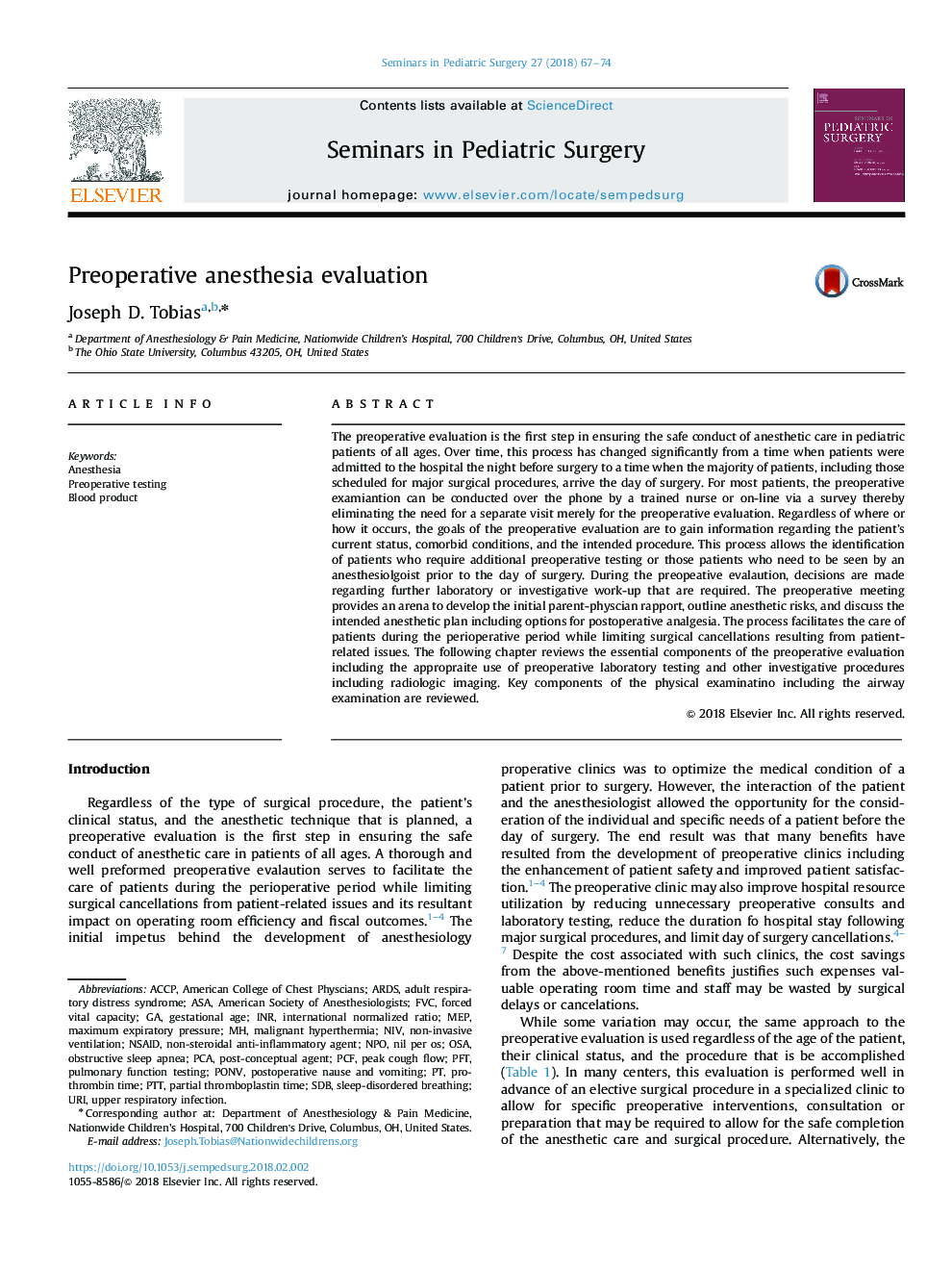| کد مقاله | کد نشریه | سال انتشار | مقاله انگلیسی | نسخه تمام متن |
|---|---|---|---|---|
| 8813794 | 1607975 | 2018 | 8 صفحه PDF | دانلود رایگان |
عنوان انگلیسی مقاله ISI
Preoperative anesthesia evaluation
ترجمه فارسی عنوان
ارزیابی بیهوشی قبل از عمل
دانلود مقاله + سفارش ترجمه
دانلود مقاله ISI انگلیسی
رایگان برای ایرانیان
کلمات کلیدی
ACCPPFTINRPCFARDSnpoNil per osNIVURIFVCPONVMEPPTTNSAIDBlood productASASDBPCA - PCAPulmonary function testing - آزمایش عملکرد ریهPreoperative testing - آزمایش قبل از عملobstructive sleep apnea - آپنه خواب انسدادیsleep-disordered breathing - اختلال تنفسی در خوابAmerican Society of Anesthesiologists - انجمن بین المللی بیهوشی آمریکاOsa - بخشAnesthesia - بیهوشیNon-invasive ventilation - تهویه غیر تهاجمیPeak cough flow - جریان سرفه بالاmaximum expiratory pressure - حداکثر فشار بیحسیPartial thromboplastin time - زمان ترومبوپلاستین جزئی استprothrombin time - زمان پروترومبینgestational age - سن حاملگیadult respiratory distress syndrome - سندرم دیسترس تنفسی بالغforced vital capacity - ظرفیت حیاتی اجباریnon-steroidal anti-inflammatory agent - عامل ضد التهابی غیر استروئیدUpper respiratory infection - عفونت تنفسی فوقانیInternational Normalized Ratio - نسبت عادی بین المللیmalignant hyperthermia - هیپرترمی بدخیم
ترجمه چکیده
ارزیابی قبل از عمل اولین گام در تضمین اجرای ایمن مراقبت های بیهوشی در کودکان در تمام سنین می باشد. با گذشت زمان، این روند به طور قابل توجهی از زمانی شروع می شود که بیماران در شب قبل از عمل به بیمارستان بستری می شوند تا زمانیکه اکثر بیماران، از جمله کسانی که برای جراحی های جراحی برنامه ریزی شده اند، در روز جراحی وارد شوند. برای اکثر بیماران، بررسی قبل از عمل ممکن است توسط یک پرستار آموزش دیده و یا به صورت آنلاین انجام شود از طریق یک نظرسنجی، بنابراین نیاز به یک بازدید جداگانه صرفا برای ارزیابی قبل از عمل حذف می شود. صرف نظر از کجا و چگونه این اتفاق می افتد، اهداف ارزیابی قبل از عمل، کسب اطلاعات در مورد وضعیت فعلی بیمار، شرایط هماهنگ و روش مورد نظر است. این فرآیند اجازه می دهد تا شناسایی بیمارانی که نیاز به آزمایش های قبل از عمل جراحی دارند یا بیماران که قبل از روز عمل جراحی نیاز به یک بیهوشی داشته باشند. در حین بررسی مقدماتی، تصمیم گیری در مورد کار آزمایشگاهی یا تحقیقی انجام می شود که مورد نیاز است. جلسه پیش از عمل جراحی برای ایجاد ارتباط اولیه پدر و مادر، خطرات بیهوشی عمومی و بحث در مورد طرح بیهوشی در نظر گرفته شده از جمله گزینه های بیهوشی پس از عمل فراهم می کند. این فرایند مراقبت از بیماران را در طول دوره حاملگی تسهیل می کند در حالیکه محدودیت های لغو جراحی ناشی از مسائل مربوط به بیمار را محدود می کند. در فصل بعد، اجزای اساسی ارزیابی قبل از عمل، از جمله استفاده مناسب از آزمایشات آزمایشگاهی قبل از عمل و سایر روش های تحقیقاتی شامل تصویربرداری رادیولوژیک بررسی می شود. جزء اصلی معاینه فیزیکی شامل آزمایش معاینه راه هوایی بررسی می شود.
موضوعات مرتبط
علوم پزشکی و سلامت
پزشکی و دندانپزشکی
پریناتولوژی (پزشکی مادر و جنین)، طب اطفال و بهداشت کودک
چکیده انگلیسی
The preoperative evaluation is the first step in ensuring the safe conduct of anesthetic care in pediatric patients of all ages. Over time, this process has changed significantly from a time when patients were admitted to the hospital the night before surgery to a time when the majority of patients, including those scheduled for major surgical procedures, arrive the day of surgery. For most patients, the preoperative examiantion can be conducted over the phone by a trained nurse or on-line via a survey thereby eliminating the need for a separate visit merely for the preoperative evaluation. Regardless of where or how it occurs, the goals of the preoperative evaluation are to gain information regarding the patient's current status, comorbid conditions, and the intended procedure. This process allows the identification of patients who require additional preoperative testing or those patients who need to be seen by an anesthesiolgoist prior to the day of surgery. During the preopeative evalaution, decisions are made regarding further laboratory or investigative work-up that are required. The preoperative meeting provides an arena to develop the initial parent-physcian rapport, outline anesthetic risks, and discuss the intended anesthetic plan including options for postoperative analgesia. The process facilitates the care of patients during the perioperative period while limiting surgical cancellations resulting from patient-related issues. The following chapter reviews the essential components of the preoperative evaluation including the appropraite use of preoperative laboratory testing and other investigative procedures including radiologic imaging. Key components of the physical examinatino including the airway examination are reviewed.
ناشر
Database: Elsevier - ScienceDirect (ساینس دایرکت)
Journal: Seminars in Pediatric Surgery - Volume 27, Issue 2, April 2018, Pages 67-74
Journal: Seminars in Pediatric Surgery - Volume 27, Issue 2, April 2018, Pages 67-74
نویسندگان
Joseph D. Tobias,
